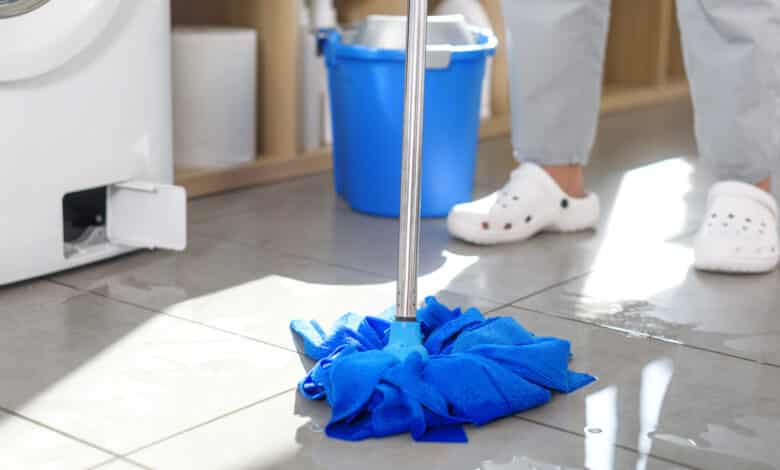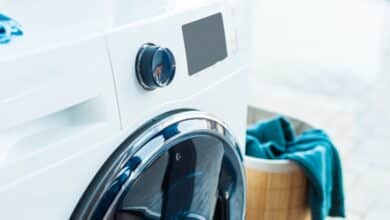
Washing machines are indispensable in modern housekeeping – they keep our clothes clean, make our everyday lives much easier and, above all, save us time that we would otherwise spend doing the laundry. But what happens if your Siemens washing machine spits out error E23 or other error codes and stops working? With a bit of bad luck, your appliance will also directly flood your premises. It is therefore important to act as quickly as possible when this error occurs.
The code usually indicates a problem with the water protection system and requires a quick solution, as this could lead to further damage to the machine or your interior if left untreated. Due to the almost identical design of many Bosch and Siemens appliances, our guide also covers Bosch washing machine error E23. The troubleshooting steps are therefore also almost identical and you can apply our tips to other washing machines with the same problem.
What does error code E23 actually mean?
Error E23 on a Siemens washing machine indicates a problem with the water protection system, which usually means that water has leaked into the floor area of the machine and activated a float switch there. This process is a safety measure designed to prevent further water ingress.
Error E23 is usually associated with the Aqua-stop system, which can be found in many modern washing machines from Siemens and Bosch. This system is designed to prevent water damage by automatically stopping the water supply when a leak is detected. This is great for preventing flooding, but if the alarm is triggered, your machine will also stop working immediately. You should therefore never delete the error code E23 directly by plugging the machine in and out. A Siemens washing machine error 23 reset may then bypass the safety precaution, even if only briefly, and with a bit of bad luck even more water may enter the appliance.
In some cases, however, it can be a very simple problem, such as a small leak or a hose that is not properly attached. After all, the entire inner workings of your washing machine are exposed to heavy loads and vibrations. In other cases, the E23 error could indicate a more serious cause, such as a faulty pump or a broken seal. However, it is important to identify and rectify the problem as quickly as possible. The good news is that you can rectify some of the causes of error E23 yourself. With a little skill and the right tool (a simple Phillips screwdriver is usually sufficient), you can identify the problem and take the necessary steps to rectify it. For stubborn cases, however, it is advisable to contact customer service.
Siemens F23 / E23 – How to start troubleshooting
To start troubleshooting, you should first look for signs of leaking water. Check the area around the washing machine for puddles or moisture. But even if you don’t find any, water may still have collected inside the machine. In any case, you should disconnect the machine from the power supply as quickly as possible and wait about 15 minutes. In many cases, this resets the electronics or the fault memory and deactivates the door lock. However, it is not always so easy to get the laundry out of the washing machine.
Siemens washing machine error E23: Unable to open door
If the washing machine displays error E23 and the door remains locked, it is necessary to use the emergency opening function. This is a safety function that is integrated into most modern washing machines to remove the laundry in the event of a fault or power failure. The emergency release is usually located at the bottom of the machine behind a flap or panel. In some cases, it is designed as a small loop or lever that you have to pull or press. At this point, it is advisable to consult the operating instructions specific to the model to find the exact position and method of the emergency release.
After the successful emergency release, you can remove your laundry at least once and continue with further troubleshooting. It is important to note that the emergency release should only be used as a last resort. You are bypassing a safety function of your appliance and may cause flooding yourself, for example if there is still water in the drum.
The fluff filter as a recurring source of problems
In the next step of troubleshooting, we will look at the lint filter, which can play a central role in a Siemens washing machine error E23. A blockage in the lint filter can prevent the water from draining properly and often leads to this error code. The good news is that checking and cleaning the lint filter is usually simple and can be carried out without specialist knowledge.
First, you should make sure that there is no more water in the machine to avoid flooding. If possible, use the pump or drain program to do this. You can then open the cover at the bottom of the washing machine, behind which the lint filter is hidden. You usually only need to open a small flap or loosen a screw to do this. Before removing the filter, place a towel and a shallow drip tray underneath to catch any remaining water.
Carefully unscrew the strainer and look out for foreign objects such as coins, hair clips or similar items that may have become trapped. Remove any objects that do not belong there and rinse the strainer and the chute thoroughly with water. Ideally, you should use a brush to remove any small residues at the same time. Then replace the fluff filter and close the maintenance opening. A test run in drain or spin mode will immediately tell you whether the problem with error E23 has been resolved or whether the washing machine needs more attention.
Check hose connections and solenoid valve
Before you tackle the more complicated options, you should definitely take a closer look at the hose connections and the solenoid valve. You will usually find the solenoid valve where the inlet hose is connected to the washing machine. It is an electrical component that controls the water supply and, as in your case, blocks the water supply in the event of an E23 error so that no major damage can occur. For a precise check, you should remove the top cover of your washing machine, which may require you to loosen two screws at the back. Then follow the water supply and look for wet spots on the solenoid valve.
If the appliance can still be switched on and operated at least briefly after a reset, you may be able to see directly where exactly water is leaking from the valve. It may also simply no longer close correctly and you may be able to detect a malfunction, for example through unusual or repetitive clicking noises.
Blocked drain pump as the cause of Siemens washing machine error E23
After checking the hose connections and the solenoid valve, it’s time to take a look at the drain pump. In most Siemens and Bosch washing machines, this is located at the bottom right behind a maintenance flap. You will usually find the pump directly behind the lint filter.
To check the drain pump, you should first make sure that the washing machine is no longer live. To do this, pull the plug out of the socket. Then remove any foreign objects and use a long screwdriver, for example, to check whether the impeller of the pump can move freely. If the impeller is blocked or the pump is heavily calcified, it should be cleaned or replaced – although you should consult a specialist for the latter.
Inspection of the bearing shaft seal
If your washing machine is displaying error E23 and you have already carried out the basic (and simple) troubleshooting steps, but the problem persists, you should next take a look at the bearing shaft seal. This seal is located directly on the bearing of your washing drum, i.e. where the rotatable drum is connected to the housing – simplified. A rubber seal on the ball bearing prevents water from entering the housing from the drum. Unfortunately, you have to unscrew the rear panel of your washing machine to do this:
- Make sure that your washing machine is no longer connected to the mains. To make it easier to reach the back, it may also make sense to remove the water and drain hose.
- Take a look at the back of your appliance. It may already have a maintenance opening that is intended for this purpose. If this is not the case, you may first have to remove the top cover to access the screws for the rear panel.
- Loosen the screws to remove the rear panel and then take a look at the drum bearing, ideally with a flashlight.
- Normally, everything should be dry here. However, if you see damp spots or leaking water, it is highly likely that the bearing seal has become porous.
- Now you have the choice between customer service and do-it-yourself. If you opt for the latter method, however, you will have a lot of work to do. And with a bit of bad luck, the drum will no longer run smoothly after reinstallation. We therefore strongly recommend method one in this case.
Leaking heating element as a source of error
Another possible cause of water in the floor area of your washing machine could be the heating element. In this case, you should also refrain from a DIY repair, as this component is not only difficult to reach on some models, but the manufacturer does not even intend for you to replace the heating element yourself. This will certainly invalidate the manufacturer’s warranty and, in the worst case scenario, you won’t be able to seal the part. However, you can still check whether the cause of the problem can be found here, especially if you have already removed the back panel anyway. Of course, you should also disconnect the appliance from the power supply during this inspection.
The heating element is usually located directly below the so-called tub, i.e. the plastic housing in which the washing drum is located. It usually protrudes directly from the back into the empty space between the drum and the tub to heat the water. You can recognize the heating element by the three cable connections and a nut between them, which can be loosened with a socket wrench. If the seal is broken, this will be noticeable as limescale residue or wet surfaces.
Check the seal between the two halves of the tub
Roughly speaking, the tub of your washing machine, i.e. the housing in which the drum rotates, consists of two halves that are connected by a seal. Water can easily leak out here too, especially if you consider how much stress is placed on the seal in this area – because strong vibrations often occur during the spin cycle. In combination with hot water and stubborn detergent residues and limescale deposits, a seal can break here.
In this case too, you can immediately recognize leaking water by the residue it causes. However, as this seal is installed a little further inside, you will ideally need a flashlight to get to the bottom of the problem.
Siemens washing machine error F23 / E23: Preventive measures
To keep your washing machine in the best possible condition and prevent faults such as Siemens washing machine error E23, you can keep a few simple but effective strategies in mind. Regular care and maintenance as well as careful and gentle handling of the machine can significantly increase its service life and prevent unexpected faults. Therefore, pay attention to the following important points:
- Using a water filter can reduce limescale in the water, which in turn reduces the build-up of limescale in the machine.
- Too much detergent can lead to foaming, irritate the sensors and trigger error messages. Therefore, always adhere to the recommended dosage.
- A regular check of the lint filter and the pump behind it prevents blockages that can lead to water build-up and error messages.
- You should also occasionally check the inlet and outlet hoses for damage or blockages.
- Setting up the washing machine straight and level ensures less vibration during the spin cycle, which protects the seals and prevents leaks.
- Use descaling agents or household remedies such as vinegar to soften and remove limescale deposits. However, make sure that you do not use too strong a cleaner to avoid damaging the hoses and seals.
These preventative steps will not only help you to avoid various problems, such as the Siemens error E23, but will also help to optimize energy consumption and improve washing performance – a win-win situation for your laundry routine.



